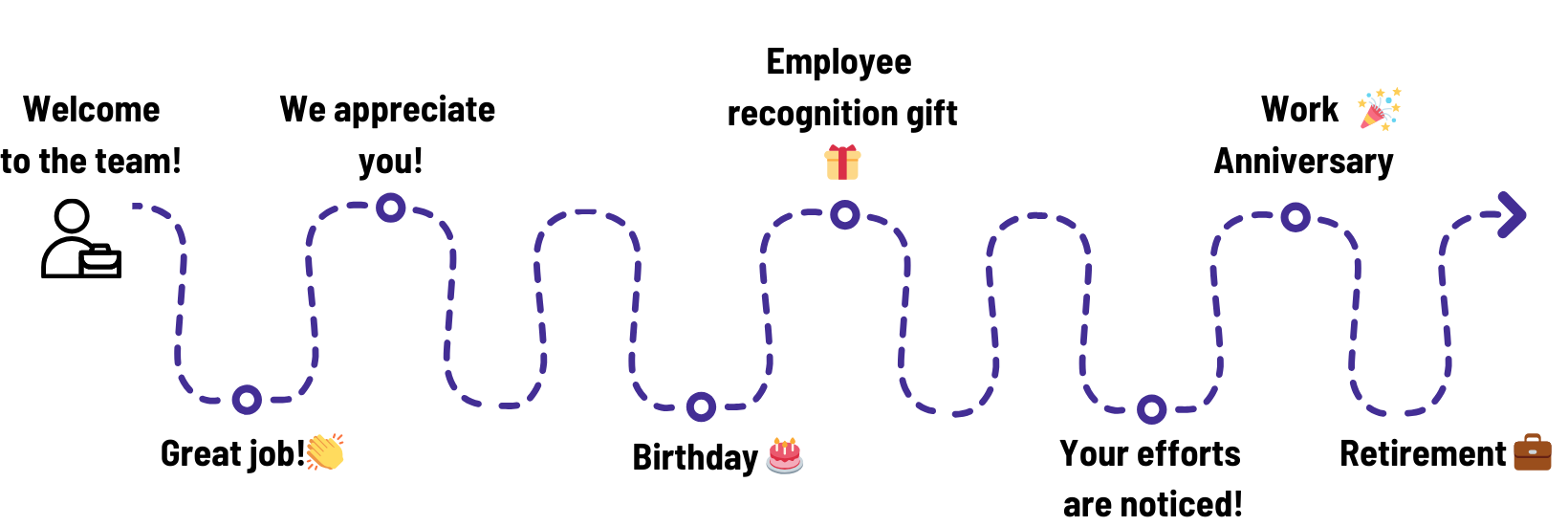Offering Recognition at Every Stage of the Employee Lifecycle
April 17, 2025, In Recruitment and Employer Brand
Organizations are constantly searching for ways to attract and retain talent. Among the most effective strategies, employee recognition stands out as a powerful lever for engagement and satisfaction. However, to be truly impactful, recognition cannot be limited to a few specific moments or certain categories of staff. It must accompany employees throughout their journey in the company.
What is the Employee Lifecycle?
The employee lifecycle refers to the different stages an employee goes through within an organization, from their first interaction with the company until their departure. This concept allows HR teams to structure their actions to offer a coherent and engaging employee experience that aligns with the company’s goals.
The employee lifecycle provides a comprehensive framework for integrating recognition at every stage of the employee journey. From the job interview to onboarding, through learning, daily performance, and professional transitions, each stage deserves a specific and adapted approach.

Let’s explore how to establish a culture of recognition that values employees at each key moment of their journey.
1. Employee Recognition During Recruitment and Onboarding

Recognition begins well before an employee officially walks through the company’s doors. From the first exchanges with a potential candidate, the organization can demonstrate that it values people’s skills and potential.
A respectful recruitment process sends a strong message about the importance given to each individual. Here’s how this can manifest
- Appreciation during the recruitment process—Take the time to acknowledge applications, provide constructive feedback, even in case of rejection, and recognize the candidate’s strengths during the interview.
- Personalized welcome program—Go beyond simple administrative formalities with a warm welcome message from management, a carefully prepared workspace, and an introduction that values the experience the recruit brings.
- Recognition of first accomplishments— The first days are crucial for establishing a positive dynamic. Celebrate the first steps, encourage questions, and value the learning curve.
This initial recognition lays the foundation for lasting engagement and concretely shows that every contribution counts, regardless of the person’s tenure. An employee whose beginnings are marked by sincere attention will more naturally develop a sense of belonging and loyalty towards the organization.
2.Recognition During the Learning and Development Phase

The learning period constitutes a phase rich in opportunities to establish a culture of recognition that values efforts as much as results. Too often, organizations expect complete mastery before recognizing an employee’s value, thus neglecting the importance of the journey taken.
A more nuanced approach involves recognizing each stage of professional development:
- Celebration of learning milestones—Recognize the progressive acquisition of new skills, highlight even modest progress, and value perseverance in the face of difficulties. This recognition of incremental progress promotes a growth mindset.
- Feedback as a recognition tool—Transform each feedback into an opportunity for appreciation. Detailed and constructive feedback demonstrates the attention paid to the employee’s work and the consideration given to their professional development.
- Investment in potential—Offering employees the opportunity to participate in training means believing in their potential. After each training session, create opportunities for them to share their new knowledge, thus doubly valuing their learning.
Training managers to deliver balanced feedback that highlights strengths while guiding toward improvement transforms each exchange into an opportunity for recognition. This approach nurtures intrinsic motivation and encourages initiative-taking, even when these involve a risk of error.
Adobe perfectly illustrates this approach of continuous recognition by replacing their annual evaluations with regular “check-ins” between managers and employees. This system promotes frequent and constructive feedback rather than periodic evaluation, thus allowing for the recognition of efforts and successes when they occur. This method increases the impact of recognition while facilitating continuous alignment of objectives.
Turn your managers into grateful leaders e with proven recognition techniques.
3. Recognition of Significant Professional and Personal Life Events

Certain key stages of the professional journey, such as service awards and important life moments, deserve special recognition. These events, often meaningful for employees, represent valuable opportunities to strengthen the bond between the individual and the organization.
Here’s how these moments can become powerful levers for recognition:
- Celebration of service awards—Marking each year of service with a symbolic or personalized gesture of appreciation reminds the employee that their loyalty and contribution are recognized. This can range from a simple personalized message to a small token of recognition, or even a more significant celebration for important milestones (5, 10, 20 years, etc.).
- Recognition of personal life events — A birth, marriage, adoption, or even a move are all moments when a word of support, a card signed by the team, or a small, thoughtful gift can make a big difference. These gestures show that the company sees beyond the professional role and considers the human in their entirety.
- Support in difficult times—Recognizing darker periods, such as grief, illness, or family challenges, through increased flexibility, a message of compassion, or a simple “I’m here if you need anything” helps create a lasting climate of trust and humanity.
4. Daily and Occasional Recognition at Work

Beyond formal moments, it’s often daily recognition that truly shapes the employee experience. These gestures, when sincere and specific, have a considerable cumulative impact on team morale and engagement.
Daily recognition can take several complementary forms:
- Spontaneous and specific words of appreciation—“Thank you for your report; I particularly appreciate the clarity of your analysis on segment B” is infinitely more rewarding than a simple generic “good job.” This precision demonstrates real attention to the work provided.
- Team rituals celebrating successes—Establish a weekly meeting that begins with a round-table of achievements or create a space dedicated to sharing collective “victories.” These rituals make contributions visible that might otherwise go unnoticed.
- Meaningful micro-recognitions— A handwritten thank you note, a personalized message, or a mention during a meeting are all simple but meaningful gestures that show the employee that their work is noticed.
- Appreciation of invisible contributions—Behind-the-scenes work, helpful behaviours, or impeccable management of administrative tasks deserve to be recognized just as much as more visible achievements.
- Peer recognition—Encourage employees to thank each other through formal programs such as recognition cards or simply by creating an environment where expressing gratitude becomes natural.
Zappos has integrated recognition into its corporate culture by developing a program called “Wow” that allows colleagues to reward each other. Each employee can give a small reward to a colleague who has demonstrated the company’s values or provided valuable help. This peer recognition system strengthens the culture of mutual support and values daily contributions that might otherwise go unnoticed.
When these daily practices become systematic, without losing their authenticity, they have the power to deeply transform organizational culture. They foster a virtuous cycle where appreciation fuels engagement, which in turn creates even more opportunities for meaningful recognition.
Give your employees the tools to value each other and cultivate a culture of recognition they won’t want to do without.
5.Recognition of Performance and Expertise

As employees develop their expertise and reach high levels of performance, recognition must evolve to continue nurturing their engagement. This stage requires a more sophisticated approach that properly values their exceptional contribution.
The following mechanisms can be particularly effective:
- Formal recognition systems—Implement rewards programs, public celebrations for major accomplishments, and promotions that visibly recognize acquired expertise.
- Valuing shared expertise—Invite experts to lead internal training sessions, seek their opinion on strategic decisions, and value their role as mentors. This recognition nurtures the feeling of impact and usefulness.
- Peer involvement—Create forums where expertise can be showcased and encourage nominations between colleagues. This collective dimension of recognition strengthens the sense of belonging.
- Visibility of collective milestones — In addition to individual accomplishments, don’t forget collective milestones such as team anniversaries, delivered projects, or achieved goals. These moments also deserve to be highlighted, thus reinforcing cohesion and collective pride.
In this phase, it is crucial to avoid the trap of routine. Even the most experienced employees need to have their value regularly recognized, but with an approach that evolves and renews itself to maintain its motivational impact.
6. Recognition During Professional Transitions

Transitions can be vulnerable moments, making recognition vital to maintaining confidence and engagement. These pivotal stages deserve special attention to be experienced as opportunities rather than disruptions.
Here’s how to adapt recognition to these key moments:
- Support during promotions—Beyond the formal announcement, officially celebrate this new stage, publicly recognize the employee’s legitimacy in their new functions, and offer visible support during the adaptation period.
- Support for internal career changes—Recognize the courage needed to change paths, value transferable skills, and celebrate successes during the learning period in the new role.
- Presence during difficult periods—Recognize resilience in the face of personal or professional challenges, temporarily adapt expectations while maintaining confidence, and value efforts made in constrained contexts.
- Celebration of new responsibilities—Even without a title change, symbolically mark the taking on of new responsibilities and value the expanded impact this represents for the organization.
These targeted approaches transform potentially stressful periods into opportunities to strengthen the bond between the employee and the organization. They demonstrate authentic consideration for the professional journey in all its complexity and evolution.
7.Recognition Upon Departure

The way an organization handles an employee’s departure says a lot about its culture and values. Even when a colleague leaves the company, recognition remains important and influences the perception that all stakeholders will keep of this shared experience.
This final stage of the cycle deserves special attention:
- Sincere thanks during a voluntary departure—Organize an attentive exit interview, share a personalized message from management, and propose a farewell celebration adapted to the person’s preferences.
- Celebrations for retirement—Honour the employee’s entire career and contributions, organize an event that reflects their impact on the organization, prepare a memory book with testimonials from colleagues to highlight all the years spent within your organization, or offer a small gift as a token of appreciation.
Conclusion

Recognition is not an isolated initiative but a mindset that must permeate all HR and managerial practices. By adapting recognition to each stage of the employee lifecycle, organizations create an environment where everyone feels valued, regardless of their tenure, hierarchical level, or journey.
The benefits of such an approach are multiple and measurable:
- Increased engagement and talent retention
- Easier attraction of new qualified employees
- Improvement of individual and collective performance
- Strengthening of a positive and authentic corporate culture
- Increased employee well-being and harmonious work climate
More than just a motivational tool, recognition becomes a fundamental pillar of the employee experience and a sustainable competitive advantage in a context where human capital represents organizations’ most precious asset.
Managers and leaders today can rethink their recognition practices so that they truly accompany each person throughout their journey. Ultimately, holistic recognition that accompanies employees throughout their professional lifecycle is not just good HR practice, but a managerial philosophy that places humans at the heart of collective performance. In an ever-changing professional world, this attention to the value of each contribution, at each stage of the journey, represents a stable anchor and bearer of meaning for both individuals and the organizations that employ them.










